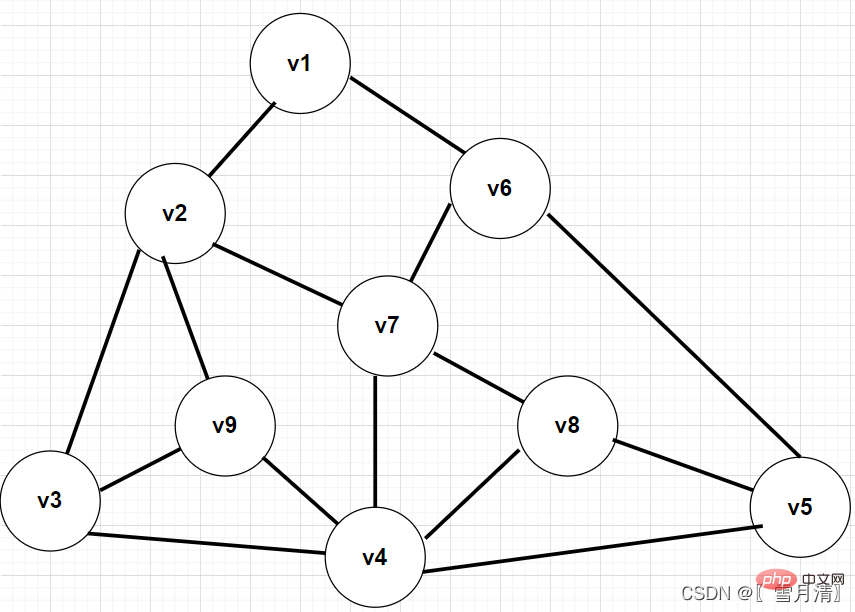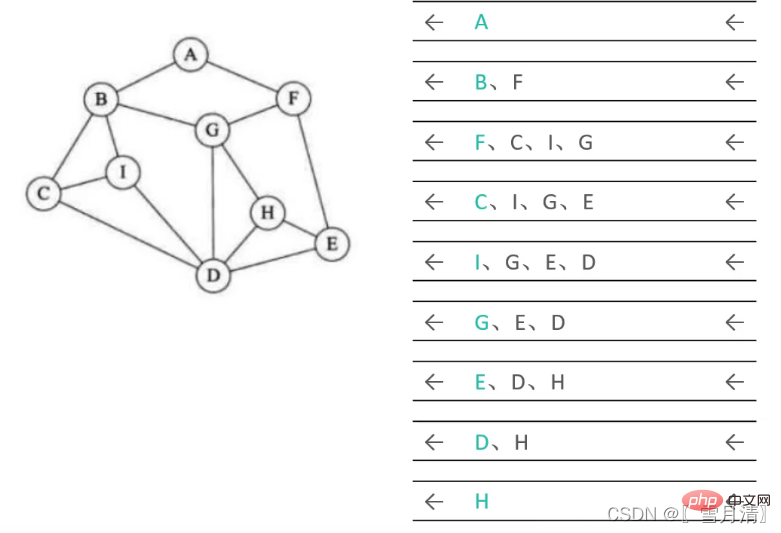How to implement graph traversal in Java
1. Graph traversal
Start from a certain vertex in the graph and visit the remaining vertices in the graph, and each vertex is only visited once
There are two types of depth-first traversal in graph traversal DFS, breadth-first traversal BFS
2. Depth-first traversal
Depth-first traversal traverses with depth first, which simply means going to the end every time. Similar to the pre-order traversal of a binary tree
Ideas:
1. Perform a depth-first traversal starting from a certain vertex, and mark the vertex as visited
2. Take the With the vertex as the starting point, select any path and traverse to the end, and mark the visited vertices
3. In step 2, traverse to the end and go back to the previous vertex, and repeat step 2
4. End of traversing all vertices
According to the traversal idea, this is a recursive process. In fact, DFS is basically the same as backtracking.
Traversal:

Take this picture as an example to perform depth-first traversal
static void dfs(int[][] graph,int idx,boolean[]visit) {
int len = graph.length;
//访问过
if(visit[idx]) return;
//访问该顶点
System.out.println("V"+idx);
//标志顶点
visit[idx] = true;
for(int i = 1;i < len;i++) {
//访问该顶点相连的所有边
if(graph[idx][i] == 1) {
//递归进行dfs遍历
dfs(graph, i, visit);
}
}
}Traversal result:
V1
V2
V3
#V4
V5
V6
V7
V8
V9
Code to create the graph:
public static void main(String[] args) {
Scanner scanner = new Scanner(System.in);
//顶点数 以1开始
int n = scanner.nextInt();
int[][] graph = new int[n+1][n+1];
//边数
int m = scanner.nextInt();
for(int i = 1;i <= m;i++) {
int v1 = scanner.nextInt();
int v2 = scanner.nextInt();
graph[v1][v2] = 1;
graph[v2][v1] = 1;
}
//标记数组 false表示未访问过
boolean[] visit = new boolean[n+1];
dfs(graph, 1, visit);
}3. Use DFS to determine whether there is a cycle in the directed graph
Idea: Traverse a certain A vertex, if in addition to the previous vertex, there are other connected vertices that have been visited, then there must be a cycle
//默认无环
static boolean flag = false;
public static void main(String[] args) {
Scanner scanner = new Scanner(System.in);
//顶点数 以1开始
int n = scanner.nextInt();
int[][] graph = new int[n+1][n+1];
//边数
int m = scanner.nextInt();
for(int i = 1;i <= m;i++) {
int v1 = scanner.nextInt();
int v2 = scanner.nextInt();
graph[v1][v2] = 1;
}
//标记数组 true为访问过
boolean[] visit = new boolean[n+1];
dfs(graph, 1, visit,1);
if(flag)
System.out.println("有环");
}
static void dfs(int[][] graph,int idx,boolean[]visit,int parent) {
int len = graph.length;
System.out.println("V"+idx);
//标记顶点
visit[idx] = true;
for(int i = 1;i < len;i++) {
//访问该顶点相连的所有边
if(graph[idx][i] == 1) {
if( !visit[i] ) {
dfs(graph, i, visit,idx);
}
else if(idx != i) {
flag = true;
}
}
}
}Note: It is a directed graph to determine whether there is a cycle, and an undirected graph to determine whether there is a cycle Whether there is a cycle is meaningless, because the vertices of any two existing paths can be cycles
4. Breadth-first traversal
Breadth-first traversal is performed with breadth (width) as priority traverse. Similar to the level-order traversal of a binary tree
Ideas:
1. Take a certain vertex as the starting point for breadth-first traversal, and mark the vertex as visited
2.Visit all Vertices that are connected to the vertex and have not been visited, and mark the visited vertices
3. Repeat steps 1 and 2 starting from the vertices visited in step 2
4.Traverse all Vertex end
The traversal is assisted by the queue, and the queue queuing order is the breadth-first traversal result

Traversal

Take this picture as an example, use the adjacency matrix method to create the graph, and perform BFS traversal
static void bfs(int[][] graph) {
int len = graph.length;
//标记数组 false表示未访问过
boolean[] visit = new boolean[len];
//辅助队列
Queue<Integer> queue = new LinkedList<>();
queue.offer(1);
visit[1] = true;
while(!queue.isEmpty()) {
int num = queue.poll();
System.out.println("V"+num);
//遍历该顶点所有相连顶点
for(int i = 1;i < len;i++) {
//相连并且没有被访问过
if(graph[num][i] == 1 && !visit[i]) {
queue.offer(i);
visit[i] = true;
}
}
}
}Traversal results:
V1
V2
V6
V3
V7
V9
V5
V4
V8
Code to create graph
public static void main(String[] args) {
Scanner scanner = new Scanner(System.in);
//顶点数 以1开始
int n = scanner.nextInt();
int[][] graph = new int[n+1][n+1];
//边数
int m = scanner.nextInt();
for(int i = 1;i <= m;i++) {
int v1 = scanner.nextInt();
int v2 = scanner.nextInt();
graph[v1][v2] = 1;
graph[v2][v1] = 1;
}
bfs(graph);
}The above is the detailed content of How to implement graph traversal in Java. For more information, please follow other related articles on the PHP Chinese website!

Hot AI Tools

Undresser.AI Undress
AI-powered app for creating realistic nude photos

AI Clothes Remover
Online AI tool for removing clothes from photos.

Undress AI Tool
Undress images for free

Clothoff.io
AI clothes remover

AI Hentai Generator
Generate AI Hentai for free.

Hot Article

Hot Tools

Notepad++7.3.1
Easy-to-use and free code editor

SublimeText3 Chinese version
Chinese version, very easy to use

Zend Studio 13.0.1
Powerful PHP integrated development environment

Dreamweaver CS6
Visual web development tools

SublimeText3 Mac version
God-level code editing software (SublimeText3)

Hot Topics
 Square Root in Java
Aug 30, 2024 pm 04:26 PM
Square Root in Java
Aug 30, 2024 pm 04:26 PM
Guide to Square Root in Java. Here we discuss how Square Root works in Java with example and its code implementation respectively.
 Perfect Number in Java
Aug 30, 2024 pm 04:28 PM
Perfect Number in Java
Aug 30, 2024 pm 04:28 PM
Guide to Perfect Number in Java. Here we discuss the Definition, How to check Perfect number in Java?, examples with code implementation.
 Random Number Generator in Java
Aug 30, 2024 pm 04:27 PM
Random Number Generator in Java
Aug 30, 2024 pm 04:27 PM
Guide to Random Number Generator in Java. Here we discuss Functions in Java with examples and two different Generators with ther examples.
 Armstrong Number in Java
Aug 30, 2024 pm 04:26 PM
Armstrong Number in Java
Aug 30, 2024 pm 04:26 PM
Guide to the Armstrong Number in Java. Here we discuss an introduction to Armstrong's number in java along with some of the code.
 Weka in Java
Aug 30, 2024 pm 04:28 PM
Weka in Java
Aug 30, 2024 pm 04:28 PM
Guide to Weka in Java. Here we discuss the Introduction, how to use weka java, the type of platform, and advantages with examples.
 Smith Number in Java
Aug 30, 2024 pm 04:28 PM
Smith Number in Java
Aug 30, 2024 pm 04:28 PM
Guide to Smith Number in Java. Here we discuss the Definition, How to check smith number in Java? example with code implementation.
 Java Spring Interview Questions
Aug 30, 2024 pm 04:29 PM
Java Spring Interview Questions
Aug 30, 2024 pm 04:29 PM
In this article, we have kept the most asked Java Spring Interview Questions with their detailed answers. So that you can crack the interview.
 Break or return from Java 8 stream forEach?
Feb 07, 2025 pm 12:09 PM
Break or return from Java 8 stream forEach?
Feb 07, 2025 pm 12:09 PM
Java 8 introduces the Stream API, providing a powerful and expressive way to process data collections. However, a common question when using Stream is: How to break or return from a forEach operation? Traditional loops allow for early interruption or return, but Stream's forEach method does not directly support this method. This article will explain the reasons and explore alternative methods for implementing premature termination in Stream processing systems. Further reading: Java Stream API improvements Understand Stream forEach The forEach method is a terminal operation that performs one operation on each element in the Stream. Its design intention is






